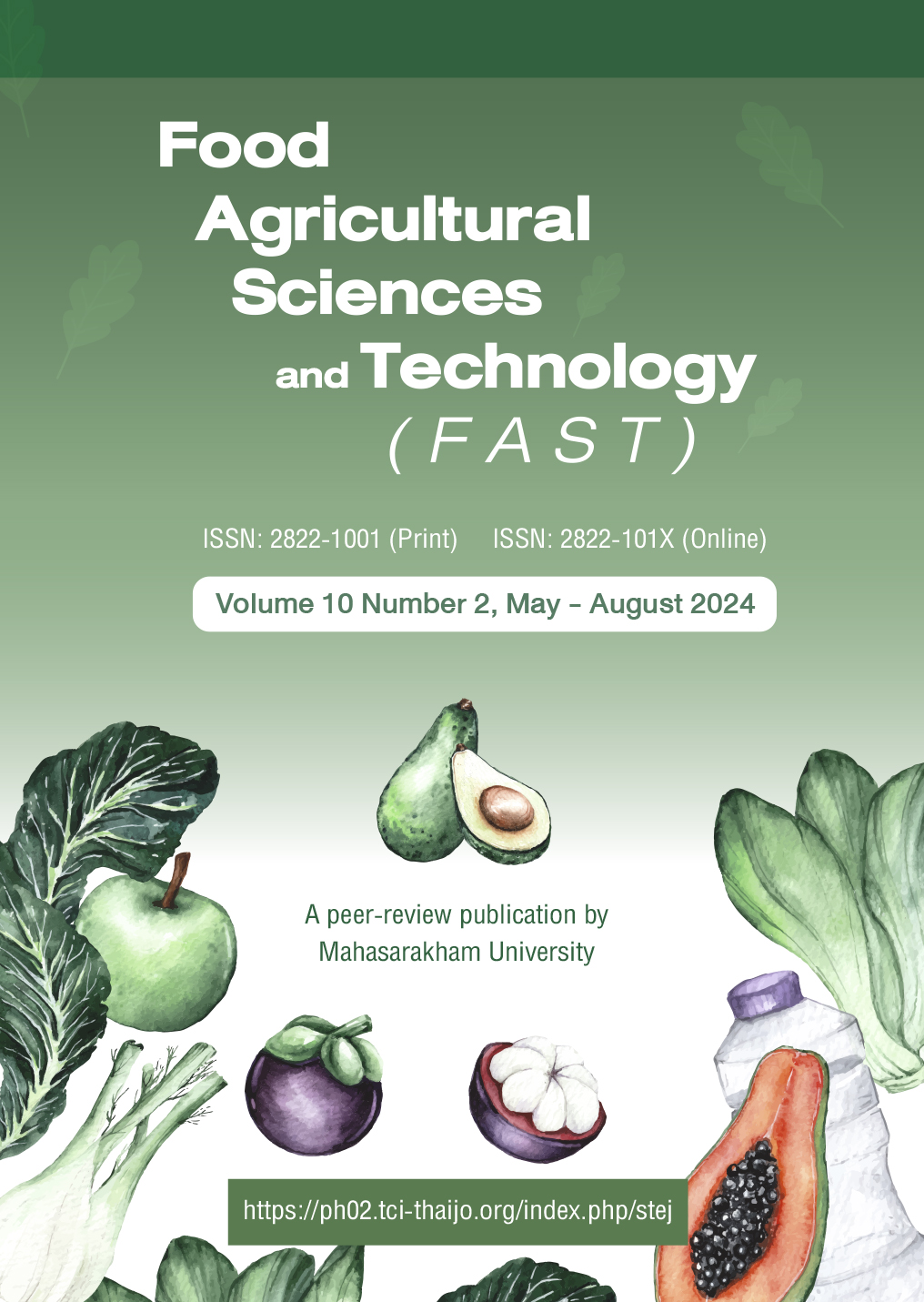Effect of behavioral enrichment on fecal corticosterone hormone levels in chimpanzees (Pan troglodytes) captive for conservation
Keywords:
Chimpanzee (Pan troglodyte), corticosterone, behavioral enrichment, captiveAbstract
Chimpanzees (Pan troglodytes) are classified as an endangered species (IUCN), therefore their conservation is important. Raising chimpanzees in a captive environments different from the natural environment may cause them to exhibit fewer natural behaviors and affect stress. Behavior enrichment is another way to help maintain animals in captivity and relieve their stress. Corticosterone is a steroid stress hormone group, that is secreted when animals are in stressful conditions with decreased immune system function. The objective of this study was to examine the effect of behavior enrichment on corticosterone levels in chimpanzees captive for conservation by collecting the fecal material of 4 chimpanzees (2 male and 2 female) before, during and after behavior enrichment, then the fecal material was dried and hormones were extracted with 90 % ethanol. The solution was analyzed for level of corticosterone hormone by ELISA technique using completely randomized design. Results of the study on corticosterone levels in male chimpanzees found that during the period of before behavior enrichment, during enrichment and after enrichment period were not significant. However, there was a continuous decrease in corticosterone levels. Corticosterone levels in female chimpanzees found that during the behavior enrichment period were higher than after enrichment and before the enrichment period, the level was not significant. The results of this study may be used as basic guideline information for designing behavior enrichment programs suitable for captive chimpanzees.
References
Abbott, D. H., Kevern, E. B., Bercovitch, F. B., Shively, C. A., Mendoza, S. P., Saltzman, W., Snowdon, C. T., Ziegler, T. E., Banjevic, M., Garland, T., & Sapolsky, R. M. (2003). Are subordinates always stressed? A comparative analysis of rank differences in cortisol levels among primates. Hormone & Behavior, 43(1), 67-82. https://doi. org/10.1016/S0018-06X(02)00037-5.
Bergman, T. J., Beehner, J. C., Cheney, D. L., Seyfarth, R. M., & Whitten, P. L. (2005). Correlates of stress in free-ranging male chacma baboons, Papio hamadryas ursinus. Animal Behaviour, 70(3), 703-713. http:// doi:10.1016/j.anbehav.2004.12.017.
Billie, J., Adrienne, A., Rachael, R., Judy, G., Marsh, P., Elizabeth, B., & Kat, V. D. (2016). Enrichment project. Project Chimps. https:// projectchimps.org/chimpanzeeenrichment/.
Boinski, S., Swing, S. P., Gross, T. S., & Davis, J. K. (1999). Environmental enrichment of brown capuchins (Cebus apella): behavioral and plasma and fecal cortisol measures of effectiveness. American Journal of Primatology, 48(1), 49-68. https://doi.org/10.1002/(SICI)1098- 2345(1999)48:1<49::AIDAJP4>3.0.CO;2-6.
Brown, J. L., Walker, S. & Steinman, K. (2004). Endocrine manual for the reproductive assessment of domestic and nondomestic species (2ed.). Smithsonian institution.
Carlstead, K. (1996). Wild mammals in captivity: Effects of captivity on the behavior of wild mammals. University of Chicago Press.
Chamove, A. S., Anderson, J. R., MorganJones, S. C., Jones, S. P. (1982). Deep woodchip litter: Hygiene, feeding, and behavioral enhancement in eight primate species. Mternational Journal for The Study of Animal Problems, 3, 308- 318.
Creel, S. (2001). Social dominance and stress hormones. Trend in Ecology & Evolution, 16(9), 491-497. https:// doi.org/10.1016/S0169- 5347(01)02227-3.
Cristiane, S. P., Manuela, G. F. G. S., Danielle, A. L., Cecília, P., Adauto, N., Priscila V. F., Cláudio, A., Oliveira, D., & Marcelo, A. B. V. G. (2015). Relation between the level of self-mutilation and the concentration of fecal metabolites of glucocorticoids in captive chimpanzees (Pan troglodytes). Pesquisa Veterinaria Brasileira, 35(1), 62-66. https:// doi.org/10.1590/S0100-736X2015 000100013.
Emery, T. M., Melissa, E. T., Stephanie, A. F., Andreas, B., Kris, H. S., Sarah P. G., Drew, K., Emily, O., Zarin, P. M., Richard, W. W., Martin, N. M. (2020). Wild chimpanzees exhibit humanlike aging of glucocorticoid regulation. Proceedings of the National Academy of Sciences (pp. 8424-8430). http://doi.org/10.1073/ pnas.1920593117.
Erwin, J., & Sackett, G. (1990). Effects of management methods, social organization, and physical space on primate behavior and health. American Journal of Primatology, 20(1), 23-30. http://doi.org/10.1002/ ajp.1350200104.
Fichtel, C., Kraus, C., Ganswindt, A., & Heistermann, M. (2007). Influence of reproductive season and rank on fecal glucocorticoid levels in free-ranging male Verreaux’s sifakas (Propithecus verreauxi). Hormones and Behavior, 51(5), 640-648. https://doi.org/10.1016/j. yhbeh.2007.03.005.
Markowitz, H., & Shirley, L. F. (1987). Artificial prey as behavioral enrichment devices for felines. Applied Animal Behaviour Science, 18(1), 38-63. https://doi. org/10.1016/0168-1591(87)90252-8.
Miller, D. B., & Jame, P. O. (2002). Neuroendocrinology of the stress-response. Behavioral Endocrinology, 51(6), 287-324. http://doi.org/ 10.1053/meta.2002 .33184.
Newton-Fisher, N. E. (2006). Female coalitions against male aggression in wild chimpanzees of the Budongo Forest. International Journal of Primatology, 27(6), 1589-1599. https://doi.org/10.1007/s10764- 006-9087-3.
Panisa, T. (2011). Promoting behavior and developing integrated quality of life for animals. Integrated conservation of the survival of all living things. 5th Zoo Wildlife Seminar.
Poole, T. B. (1991). Primate responses to environmental change. Springer Book Archive. https://doi.org/10.1007/ 978-94-011-3110-0_19.
Romero, L. M., & Remage-Healey, L. (2000). Daily and Seasonal Variation in Response to Stress in Captive Starlings (Sturnus Vulgaris): Glucose. General and Comparative Endocrinology, 119(1), 60-68. https://doi.org/10.1006/ gcen.2000.7492.
Rothschild, M. D., Serfass, T. L., Seddon, W. L., Hegde, L., & Fritz R. S. (2008). Using Fecal Glucocorticoids to Assess Stress Levels in Captive River Otters. Journal of Wildlife Management, 72(1),138-142. https://doi.org/10.2193/2005-700.
Sapolsky, R. M. (1992). Cortisol concentrations and the social significance of rank instability among wild baboons. Psychoneuroendocrinology, 17(6), 701-709. https://doi.org/10.1016/ 0306-4530(92)90029-7.
Setchell, J. M., Charpentier, M., & Wickings, E. J. (2005). Mate guarding and paternity in mandrills: factors influencing alpha male monopoly. Animal Behaviour, 70(5), 1105-1120. https://doi.org/10.1016/j. anbehav.2005.02.021.
Setchell, J. M., Smith, T., Wickings, E .J., & Knapp, L. A. (2010). Stress, social behaviour, and secondary sexual traits in a male primate. Hormones and Behavior, 58(5), 720-728. https://doi.org/10.1016/j. yhbeh.2010.07.004.
Soma, K. K. (2006). Testosterone and Aggression: Berthold, birds and beyond. Journal of Neuroendocrinology, 18(7), 543-551. http://doi:10.1111 /j.1365-2826.2006.01440.
Whitten, P. L., Stavisky, R., Aureli, F., & Russell, E. (1998). Response of fecal cortisol to stress in captive chimpanzees (Pan troglodytes). American Journal of Primatology, 44(1), 57-69. https://doi.org/ 10.1002/(SICI)1098-2345(1998) 44:1<57:AID-AJP5>3.0.CO;2-W.
Whiten, A., Goodall, J., McGrew, W. C., Nishida, T., Reynolds, V. S. Y., Tutin, C. E. G., Wrangham, R. W., & Boesch, C. (2001). Charting cultural variation in chimpanzees. Behaviour, 138(11), 1481-1516. http://doi:org/10.1163/156853 901317367717.
Wurbel, H., Stauffacher, M., von-Holst, D. (1996). Stereotypies in laboratory mice-Quantitative and qualitative description of the ontogeny of wire gnawing and jumping in ICR and ICR nu-mice. Ethology International Journal of Behavioral Biology, 102(5), 371-385. https:// doi.org/10.1111/j.1439-0310.1996. tb01133.x.
Yoshinao, K., & Michael, E. B. (2021). Handbook of hormones comparative endocrinology for basic and clinical research. Academic Press. Young, R. J. (2003). Environmental enrichment for captive animals. Blackwell Science.
Downloads
Published
How to Cite
Issue
Section
License
Copyright (c) 2024 Food Agricultural Sciences and Technology

This work is licensed under a Creative Commons Attribution-NoDerivatives 4.0 International License.








